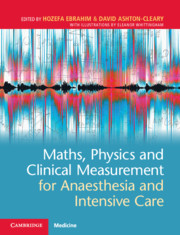Book contents
- Maths, Physics and Clinical Measurement for Anaesthesia and Intensive Care
- Maths, Physics and Clinical Measurement for Anaesthesia and Intensive Care
- Copyright page
- Dedication
- Contents
- List of contributors
- Preface
- Acknowledgements
- Abbreviations
- Chapter 1 Data Analysis and Medical Statistics
- Chapter 2 Basic Physics and Electronics
- Chapter 3 Heat, Temperature and Humidity
- Chapter 4 Behaviour of Fluids
- Chapter 5 Gas Measurement and Supply
- Chapter 6 Gas Concentration Measurement
- Chapter 7 Blood Gas Analysis
- Chapter 8 Vapours and Vaporizers
- Chapter 9 Ventilators and Breathing Systems
- Chapter 10 Safety in the Clinical Environment
- Chapter 11 Blood Pressure Measurement
- Chapter 12 Cardiac Output Monitoring
- Chapter 13 Cardiac Support Equipment
- Chapter 14 Ultrasound and Doppler
- Chapter 15 Atomic Structure, Radiation, Imaging and Lasers
- Chapter 16 Electro-biophysiology
- Index
- References
Chapter 4 - Behaviour of Fluids
Published online by Cambridge University Press: 30 August 2019
- Maths, Physics and Clinical Measurement for Anaesthesia and Intensive Care
- Maths, Physics and Clinical Measurement for Anaesthesia and Intensive Care
- Copyright page
- Dedication
- Contents
- List of contributors
- Preface
- Acknowledgements
- Abbreviations
- Chapter 1 Data Analysis and Medical Statistics
- Chapter 2 Basic Physics and Electronics
- Chapter 3 Heat, Temperature and Humidity
- Chapter 4 Behaviour of Fluids
- Chapter 5 Gas Measurement and Supply
- Chapter 6 Gas Concentration Measurement
- Chapter 7 Blood Gas Analysis
- Chapter 8 Vapours and Vaporizers
- Chapter 9 Ventilators and Breathing Systems
- Chapter 10 Safety in the Clinical Environment
- Chapter 11 Blood Pressure Measurement
- Chapter 12 Cardiac Output Monitoring
- Chapter 13 Cardiac Support Equipment
- Chapter 14 Ultrasound and Doppler
- Chapter 15 Atomic Structure, Radiation, Imaging and Lasers
- Chapter 16 Electro-biophysiology
- Index
- References
Summary
Consider a normal day working as an anaesthetist. There are various phenomena that we may take for granted. These may range from the force we may exert when injecting through a syringe, the time it takes to pour honey into our porridge or the temperature of our bicycle tyre after a 60-minute cycle. The physical principles behind these phenomena make for interesting reading.
- Type
- Chapter
- Information
- Publisher: Cambridge University PressPrint publication year: 2019
References
- 1
- Cited by

